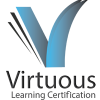Subscribe to get updates about new courses and the books added to our library!
Virtuous is unique in its kind by providing the end-to-end automated learning and certification to its learners with a simplified process from the enrollment to the certification.
help center
- Contact Us
- Terms & Conditions
- Privacy Policy
Get In Touch
- 20-22 Wenlock Road, London, England, N1 7GU
- vlc@virtuouscourses.com

